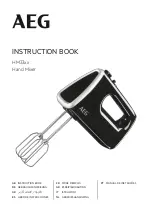
Guided Tour - Mono and Stereo Channels
1: Mic inputs (1 - 5) - Provided in monophonic channels only. Use these electronically balanced
XLR jacks to connect microphones to any of the MPL 1502’s five mono channels (channels 1 - 5).
These are intended to accept signal from low-level, low-impedance mics but can also be used for
signal from other sources (such as direct injection boxes) if the channel’s Trim control is turned
down. WARNING: Do not turn Phantom power on if signal sources other than microphones are
connected to any of these inputs. Also, do not connect a channel’s microphone input if you
already have something connected to its line input; each channel is designed to accept only one
source or the other.
2: Line inputs (1 - 15) - Use these standard 1/4” jacks to connect line-level sources such as
synthesizers, drum machines, CD players, tape decks, or effects processors to any of the MPL
1502’s fifteen mono or stereo channels. The line input jacks for monophonic channels (channels
1 - 5) are electronically balanced, so you should use balanced three-conductor cabling and
Tip/Ring/Sleeve (TRS) plugs wherever possible (unbalanced two-conductor plugs can also be
inserted into these inputs, but you’ll get better signal quality and less outside noise and hum if you
use balanced lines). The line input jacks for stereo channels (channels 6 - 15) are unbalanced.
When connecting only one monophonic signal to stereo channels, use the left (even-numbered)
input; the MPL 1502 will then treat that channel as if it is a mono channel, allowing the signal to
be panned (using the Balance control)—see the “Using Pan/Balance” section on page 18 for
more information. The “Connecting The MPL 1502” section on page 10 provides more informa-
tion on how best to use channel inputs. WARNING: Do not connect a channel’s line input if you
already have something connected to its microphone input; each channel is designed to accept
only one source or the other.
3: Trim (black) - This knob determines the input level of the connected mic or line signal.
In stereo channels, it determines the input level of both the left and right inputs. Continuously
adjustable from +4 dB to -50 dB (for mono channels) or +4 dB to -30 dB (for stereo channels), the
input trim is at unity gain (no boost or cut) when set to the “0” (9 o’clock) position. The input
signal is boosted when the trim is turned to the right of “0” and attenuated when turned to the left
of “0.” For information on how to properly set this for each channel, see the section on page 14
entitled “Setting The Correct Gain Structure.”
4: Equalizer (blue) - These knobs determine the amount of boost or attenuation in each of three
frequency areas. The high and low frequency knobs provide 15 dB of cut or boost at 10 kHz and
80 Hz, respectively, while the mid frequency knob provides 12 dB of cut or boost at 800 Hz.
The low and mid frequency controls utilize a resonant (“bell”) peaking curve, while the high
frequency control utilizes a shelving curve. In stereo channels, EQ settings affect both the left
and right inputs, although the signals remain separate. A center detent in each knob (at the “0”
position) indicates no boost or attenuation (that is, flat response). As each knob is turned
clockwise from the “0” position, the frequency area is boosted; as it is turned counterclockwise
from the “0” position, the frequency area is attenuated. For more information on the application of
EQ, see the “Using Equalization” section on page 19.
5: Auxiliary sends (light gray) - These knobs allow you to route signal to either or both of the
MPL 1502’s two monophonic Auxiliary outputs. These are typically used to create submixes (for
example, a headphone cue mix) and to feed signal from single or multiple channels to outboard
effects devices. At the “0” (2 o’clock) position, the signal is routed with unity gain (that is, no
boost or attenuation). As each knob is turned clockwise from the “0” position, the signal is
boosted; as it is turned counterclockwise from the “0” position, it is attenuated. Both Aux send 1
and Aux send 2 are post-fade; that is, the level of the signal is determined by the channel’s input
trim, its EQ settings, and the position of its gain control.
4
1
2
3
−∞
−∞
−∞
+15
1
-50
+4
0
10
TRIM
HIGH
-15
+15
0
MID
-15
+15
0
LOW
-15
+15
0
+10
AUX 1
1
GAIN
0
PEAK
PAN
L
R
AUX 2
+10
0
0
1
2
3
4
5
6
8
9
Summary of Contents for MPL 1502
Page 1: ......







































